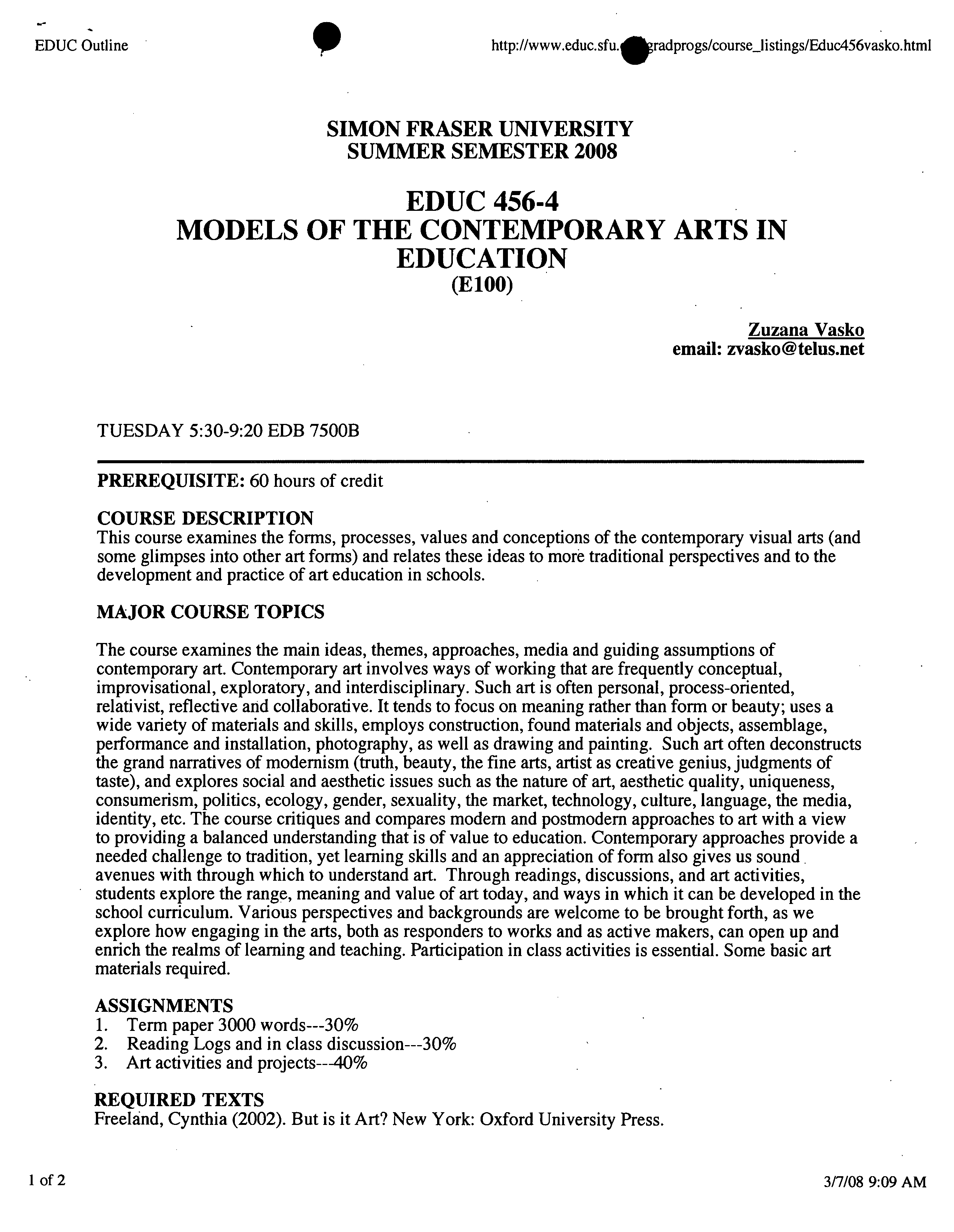http://www.educ.sfu.radprogs/course_listings/Educ456vasko.htm1
SIMON FRASER UNIVERSITY
?
SUMMER SEMESTER 2008
EDUC
456-4?
MODELS OF THE CONTEMPORARY ARTS IN ?
EDUCATION ?
(E100)
Zuzana Vasko
email: zvasko@telus.net
TUESDAY 5:30-9:20 EDB 7500B
PREREQUISITE:
60 hours of credit
COURSE DESCRIPTION
This course examines the forms, processes, values and conceptions of the contemporary visual arts (and
some glimpses into other art forms) and relates these ideas to more traditional perspectives and to the
development and practice of art education in schools.
MAJOR COURSE TOPICS
The course examines the main ideas, themes, approaches, media and guiding assumptions of
contemporary art. Contemporary art involves ways of working that are frequently conceptual,
improvisational, exploratory, and interdisciplinary. Such art is often personal, process-oriented,
relativist, reflective and collaborative. It tends to focus on meaning rather than form or beauty; uses a
wide variety of materials and skills, employs construction, found materials and objects, assemblage,
performance and installation, photography, as well as drawing and painting. Such art often deconstructs
the grand narratives of modernism (truth, beauty, the fine arts, artist as creative genius, judgments of
taste), and explores social and aesthetic issues such as the nature of art, aesthetic quality, uniqueness,
consumerism, politics, ecology, gender, sexuality, the market, technology, culture, language, the media,
identity, etc. The course critiques and compares modern and postmodern approaches to art with a view
to providing a balanced understanding that is of value to education. Contemporary approaches provide a
needed challenge to tradition, yet learning skills and an appreciation of form also gives us sound.
avenues with through which to understand art. Through readings, discussions, and art activities,
students explore the range, meaning and value of art today, and ways in which it can be developed in the
school curriculum. Various perspectives and backgrounds are welcome to be brought forth, as we
explore how engaging in the arts, both as responders to works and as active makers, can open up and
enrich the realms of learning and teaching. Participation in class activities is essential. Some basic art
materials required.
ASSIGNMENTS
1.
Term paper 3000 words---30%
2.
Reading Logs and in class discussion---30%
3.
Art activities and projects--40%
REQUIRED TEXTS
Freeland, Cynthia (2002). But is it Art? New York: Oxford University Press.
lof 2 ?
3/7/08 9:09 AM
http://www.educ.sfugradprogs/course_listings/Educ456vasko.htm1
ISBN 0 19210055 6pbk
Walker, Sydney, R. (2001) Teaching Meaning in Artmaking. Worcester: Davis Publications. ISBN
87192 583 4pbk
Students in all Faculty of Education courses are encouraged to review policies pertaining to academic
integrity available on the Undergraduate Programs website:
http://www
.edLIC.SfU.ca/u-aradpro2s/studeiit
resources/index.html
2of2 ?
3/7/08 9:09 AM


